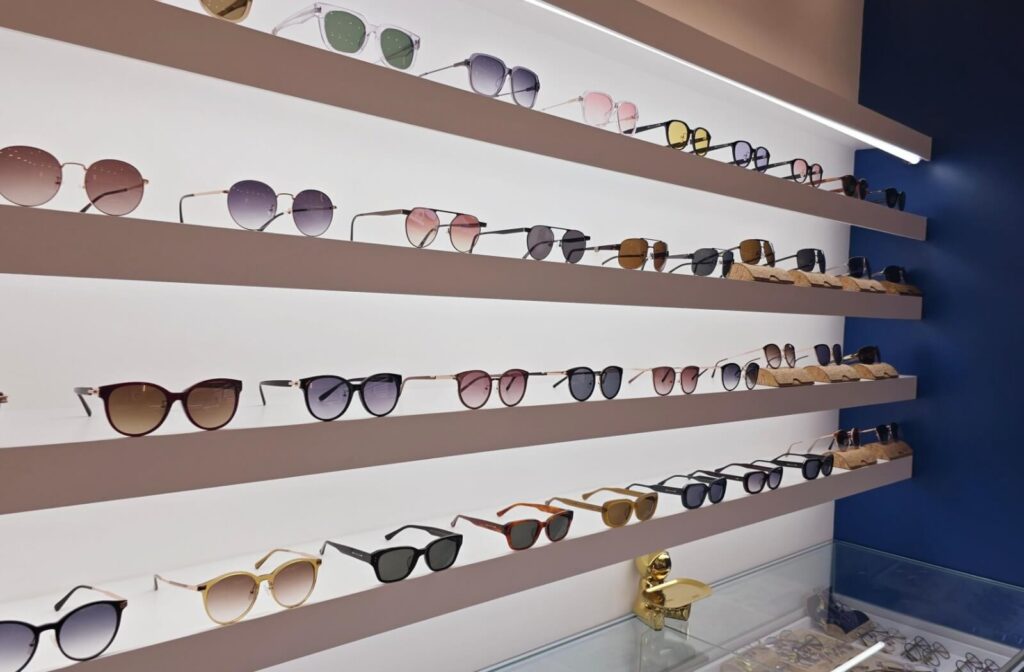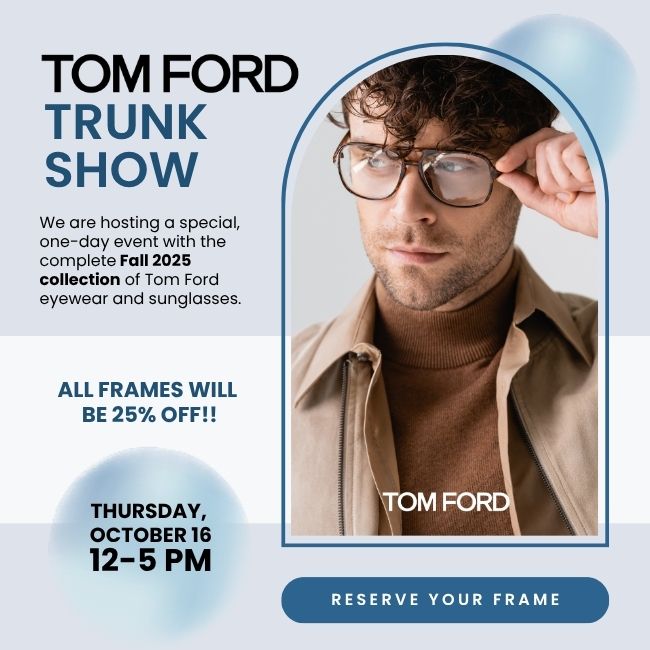Sunglasses are more than just a fashion statement—they help protect your eyes from glare and harmful UV rays. Polarized sunglasses take this protection a step further by reducing glare, enhancing visual clarity, and improving comfort in bright conditions.
But how can you tell if a pair of sunglasses is polarized? Look at a reflective surface and tilt them to see if glare reduces, view a phone or computer screen while rotating your head to see if it darkens, hold two pairs together and rotate one at a 90-degree angle to check for darkening, or check the label for polarization markings.
Whether you’re buying a new pair or checking one you already own, these simple ways test polarization and let you know if you’re getting the benefits these specialized lenses offer. Before buying a new pair of sunglasses, book a regular eye exam to see if prescription sunglasses may be better suited for you.
Understanding Damage from UV Rays
To understand how polarized and non-polarized sunglasses protect your eyes, it helps to know what they shield against. According to the Canadian Association of Optometrists, there are three main types of ultraviolet (UV) rays that can impact eye health:
- UVA (Ultraviolet A) – The weakest but most persistent type of UV radiation, UVA rays pass through the atmosphere completely and can cause long-term eye damage.
- UVB (Ultraviolet B) – Stronger than UVA rays, UVB radiation is partially absorbed by the ozone layer, but enough reaches the earth’s surface that can contribute to serious eye conditions.
- UVC (Ultraviolet C) – The most intense form of UV radiation, UVC rays are completely blocked by the ozone layer, so they don’t pose a natural risk to eye health.
Since UVA and UVB rays penetrate the atmosphere year-round, UV protection is needed, even on cloudy days.
How UV Rays Affect Your Eyes
Wearing sunglasses that don’t block UV rays can leave your eyes exposed to harmful radiation, leading to long-term damage—even if you don’t notice symptoms right away. Excessive UV exposure increases the risk of developing serious eye conditions, including:
- Corneal damage – Prolonged UV exposure can lead to photokeratitis, a painful condition similar to sunburn on the surface of the eye.
- Macular degeneration – UV damage contributes to the breakdown of the macula, the part of the retina responsible for sharp central vision.
- Cataracts – UV radiation can accelerate the development of cataracts, causing clouding of the eye’s natural lens and vision impairment.
- Abnormal growths on the eye – Pterygium, fleshy tissue growth on the white of the eye, is linked to UV exposure and can affect vision over time.
Since UV-related eye conditions can develop without early symptoms, regular eye exams with an optometrist are crucial for detecting and managing potential damage before it worsens.
What Are Polarized Sunglasses?
Polarized sunglasses have a special chemical coating that helps block intense reflected light, commonly known as glare. This makes them especially useful for outdoor activities like driving, boating, skiing, and hiking.
Unlike standard tinted sunglasses, which only reduce brightness, polarized lenses filter out horizontal light waves, improving contrast and reducing eye strain. This can result in clearer, more comfortable vision in bright conditions.
How to Tell If Sunglasses Are Polarized
If you’re unsure whether your sunglasses are polarized, there are a few easy ways to check.
The Reflection Test
This test works best on water, car windshields, or smooth roads.
- Hold the sunglasses in front of your eyes and look at a bright reflection.
- Slowly tilt the lenses 90 degrees while keeping your focus on the glare.
- If the glare diminishes or disappears, the lenses are polarized. If nothing changes, they are likely standard tinted lenses.
The Screen Test
Most LCD and LED screens, such as those on phones, tablets, or laptops, already have built-in polarization.
- Wear your sunglasses and look at a digital screen.
- Rotate your head or the screen slightly to the side.
- If the screen darkens or becomes difficult to see, your sunglasses are polarized. If there’s no change, they are not.
The Double-Lens Test
If you have another pair of polarized sunglasses, you can use them for a simple test.
- Hold one pair of sunglasses in front of the other.
- Rotate one pair 90 degrees against the other.
- If the overlapping area darkens or turns black, both pairs are polarized. If the lenses remain clear, at least one pair is not.
Check the Label
New polarized sunglasses often come with a sticker or tag indicating polarization. However, labels alone aren’t always reliable—verifying with one of the above tests assures accuracy.

Benefits of Polarized Sunglasses
For those who spend a lot of time outdoors, polarized sunglasses offer multiple advantages beyond standard UV protection.
Reduced Glare
Glare from water, pavement, and glass surfaces can cause discomfort and reduce visibility. Polarized lenses cut through this glare, making it easier to see clearly.
Enhanced Visual Clarity
By filtering out scattered light, polarized sunglasses improve contrast and colour perception. This can make objects appear sharper and more defined.
Less Eye Strain
Bright, reflected light forces your eyes to work harder. Polarized lenses reduce this strain, minimizing fatigue, squinting, and headaches.
Improved Safety
Better visibility can mean safer driving, boating, and outdoor sports. Clearer vision helps detect obstacles, changes in terrain, or other vehicles more easily.
UV Protection
Many polarized lenses also block 100% of UVA and UVB rays, protecting your eyes from long-term sun damage. However, not all polarized sunglasses include UV protection—always check the label before purchasing.
When Should You Wear Polarized Sunglasses?
Polarized sunglasses are ideal for high-glare environments, including:
- Driving – Reduces glare from wet roads and windshields.
- Boating & fishing – Cuts through water glare, making it easier to see beneath the surface.
- Hiking & outdoor sports – Provides better visibility in bright, sunny conditions.
- Winter activities – Minimizes glare from snow and ice.
Are There Times When Polarized Sunglasses Aren’t Ideal?
While polarized sunglasses work well in most settings, there are a few situations where they may not be the best choice.
- Pilots & equipment operators – Some digital screens and aircraft instruments use polarized light, making them harder to read through polarized lenses.
- Night driving – Polarized lenses reduce overall brightness, which can make it harder to see in low-light conditions.
- Certain winter sports – Some skiers and snowboarders prefer non-polarized lenses to detect icy patches more clearly.
Choosing the Right Polarized Sunglasses
When selecting polarized sunglasses, consider these factors:
- Lens quality – Higher-quality lenses can provide better clarity and durability.
- Frame fit – Choose a style that offers comfort and full eye coverage.
- UV protection – Make sure the lenses block 100% of UVA and UVB rays.
- Activity-specific needs – Different tints and coatings work better for sports, driving, or everyday wear.
iSight Optometry: Your Partner in Eye Care
Knowing whether your sunglasses are polarized can help maximize eye comfort, reduce glare, and improve vision in bright conditions. Simple tests like the reflection test or screen test can help determine if your lenses are truly polarized.
If you’re looking for polarized sunglasses that combine glare reduction and full UV protection, visit iSight Optometry in Kelowna, BC. Our team is ready and waiting to help you find the perfect pair for your lifestyle and vision needs.





